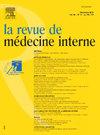Immune checkpoint inhibitor-related eosinophilic fasciitis: 3 case reports with literature review
IF 0.9
4区 医学
Q3 MEDICINE, GENERAL & INTERNAL
引用次数: 0
Abstract
Introduction
Immune checkpoint inhibitors (ICIs) are associated with a large spectrum of immune-related Adverse Events (irAEs). ICIs can exceptionally induce eosinophilic fasciitis (EF). Data of ICI-related EF (ICI-EF) are scarce without clear guidelines on both diagnosis and treatment.
Methods
We conducted a literature review of all cases of patients over 18 years old with EF diagnosis following ICI treatment between 2016 and November 2023 and meeting Pinal-Fernandez's criteria. New cases from two departments (French Region of Occitania) were added to complete the cohort.
Results
We selected 30 cases: 27 from literature review and 3 new cases diagnosed in Occitania. There was male predominance, with a sex ratio (M/F) of 1.3 with a median age of 57 years. The most common tumor was melanoma (50%). The time to onset was 10 months. Twenty-two patients (73%) had hypereosinophilia (mean 3300/mm3). A large majority (25/30, 83%) received at least one course of steroids therapy while immunosuppressive treatment was needed for 18 patients (72%). Rechallenge was proposed in 2 patients without recurrence of EF.
Discussion
Clinical and biological characteristics appeared roughly similar between ICI-EF and idiopathic-EF. Management is currently based on clinical practice of idiopathic-EF with corticosteroids often used in first line of treatment. However, a second line (methotrexate of mycophenolate mofetil) was required in majority of patients as observed in idiopathic-EF.
Conclusion
There is a significant reporting signal of EF following ICIs. A proactive management is required in all cases. A specific algorithm for treatment is finally proposed.
免疫检查点抑制剂相关嗜酸性筋膜炎3例报告并文献复习。
免疫检查点抑制剂(ICIs)与一系列免疫相关不良事件(irAEs)相关。ICIs可异常诱导嗜酸性筋膜炎(EF)。icii相关EF (icii -EF)的数据很少,缺乏明确的诊断和治疗指南。方法:我们对2016年至2023年11月期间所有18岁以上经ICI治疗后诊断为EF且符合Pinal-Fernandez标准的患者进行了文献综述。来自两个省(奥西塔尼亚法国大区)的新病例被加入到完整的队列中。结果:我们选择了30例病例,其中27例来自文献查阅,3例来自新发病例。男性居多,性别比(M/F)为1.3,中位年龄为57岁。最常见的肿瘤是黑色素瘤(50%)。发病时间为10个月。22例患者(73%)患有嗜酸性粒细胞增多症(平均3300/mm3)。绝大多数(25/ 30,83 %)接受了至少一个疗程的类固醇治疗,而18例(72%)患者需要免疫抑制治疗。2例EF无复发的患者提出再挑战。讨论:ci - ef和特发性ef的临床和生物学特征大致相似。目前的治疗是基于特发性ef的临床实践,皮质类固醇通常用于一线治疗。然而,大多数特发性ef患者需要二线治疗(甲氨蝶呤霉酚酸酯)。结论:ici后有明显的EF报告信号。在所有情况下都需要主动管理。最后提出了一种具体的处理算法。
本文章由计算机程序翻译,如有差异,请以英文原文为准。
求助全文
约1分钟内获得全文
求助全文
来源期刊

Revue De Medecine Interne
医学-医学:内科
CiteScore
0.70
自引率
11.10%
发文量
526
审稿时长
37 days
期刊介绍:
Official journal of the SNFMI, La revue de medecine interne is indexed in the most prestigious databases. It is the most efficient French language journal available for internal medicine specialists who want to expand their knowledge and skills beyond their own discipline. It is also the main French language international medium for French research works. The journal publishes each month editorials, original articles, review articles, short communications, etc. These articles address the fundamental and innumerable facets of internal medicine, spanning all medical specialties. Manuscripts may be submitted in French or in English.
La revue de medecine interne also includes additional issues publishing the proceedings of the two annual French meetings of internal medicine (June and December), as well as thematic issues.
 求助内容:
求助内容: 应助结果提醒方式:
应助结果提醒方式:


